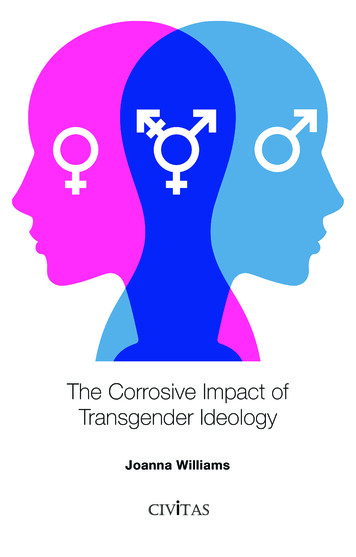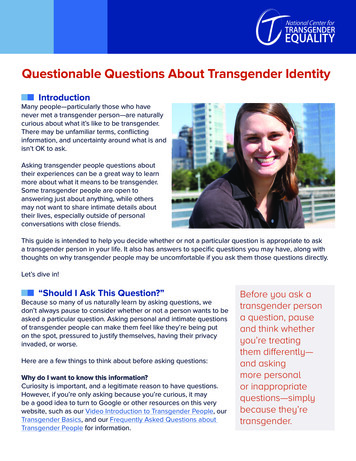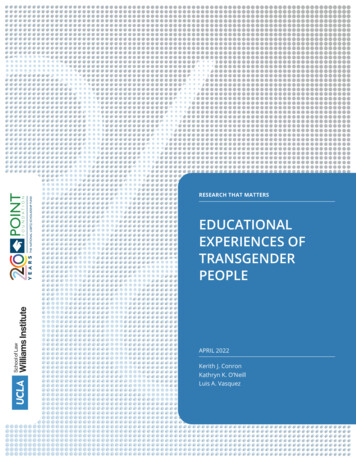
Transcription
Transgender Student Guidance for School DistrictsThe New Jersey Law Against Discrimination (“NJLAD”), N.J.S.A. 10:5-12(11)(f), generally makes itunlawful for schools to subject individuals to differential treatment based on race, creed, color,national origin, ancestry, marital status, domestic partnership or civil union status, sex, affectional orsexual orientation, gender identity or expression, disability or nationality.Title IX of the Education Amendments of 1972 (“Title IX”) specifically prohibits discrimination on thebasis of sex in federally-funded education programs and activities [20 U.S.C. § 1681(a)].N.J.S.A. 18A:36-41 directs the Commissioner of the New Jersey Department of Education to establishguidelines to provide direction for schools in addressing common issues concerning the needs oftransgender students, and to assist schools in establishing policies and procedures that ensure asupportive and nondiscriminatory environment for transgender students.This guidance was prepared by the New Jersey Department of Education after a review of policies andguidance from other states and organizations, and in consultation with educators, counselors, schoolpsychologists, advocates, and parents. The intended purpose of this guidance is to help school anddistrict administrators take steps to create an inclusive environment in which transgender and gendernonconforming students feel safe and supported, and to ensure that each school provides equaleducational opportunities for all students, in compliance with N.J.A.C. 6A:7-1.1 et seq.Communication with the student is paramount. Schools and school districts are encouraged tocommunicate openly, albeit confidentially, with students regarding their transgender status or genderidentity. Proper communication with the student will ensure that appropriate steps are taken todetermine a student’s preferences and address potential privacy concerns and associated risks to thestudent’s well-being.1. DefinitionsA safe and supportive environment within a school begins with understanding and respect.Students, teachers, and administrators should be provided with common terminology associatedwith gender identity. Although these terms are commonly used by advocacy and human rightsgroups, students may prefer other terms to describe their gender identity, appearance, or behavior. Gender Identity means a person's internal, deeply held sense of gender. All people have agender identity, not just transgender people. For transgender people, the individual’sinternal gender identity is not the same as the gender assigned at birth.Gender Expression means external manifestations of gender, expressed through a person'sname, pronouns, clothing, haircut, behavior, voice, and/or body characteristics. Society
identifies these cues as masculine and feminine, although what is considered masculine orfeminine changes over time and varies by culture.Assigned Sex at Birth (ASAB) refers to the biological sex designation recorded on a person’sbirth certificate upon the initial issuance of that certificate, should such a record beprovided at birth.Gender Assigned at Birth refers to the gender a child is assigned at birth or assumed to be,based on their biological sex assigned at birth.Sexual Orientation describes a person's enduring physical, romantic, and/or emotionalattraction to another person. Gender identity and sexual orientation are not the same. Atransgender person may be straight, lesbian, gay, bisexual, or asexual. For example, aperson who transitions from male to female and is attracted solely to men may identify as astraight woman.Transgender is a term for an individual whose gender identity and/or gender expressiondiffers from those typically associated with the sex and gender assigned at birth.Transition is the process by which a transgender person recognizes that their authenticgender identity is not the same as the gender assigned at birth, and develops a moreaffirming gender expression that feels authentic. Some individuals socially transition, forexample, through dress, use of names and/or pronouns. Some individuals may undergo aphysical transition, which might include hormone treatments and surgery. School districtpersonnel should avoid the phrase “sex change,” as it is an inaccurate description of thetransition process; the process is more accurately described as “gender-confirming.”LGBTQ is an acronym for “lesbian, gay, bisexual, transgender, and queer/questioning.”Gender nonconforming describes a person whose gender expression does not conform tothe gender expectations of their family or community. Gender nonconformity is notnecessarily an indication that a youth is transgender; many non-transgender youth do notconform to stereotypical expectations.Gender Expansive/Gender Diverse/Gender Fluid/Gender Non-Binary/Agender/GenderQueer are terms that convey a wider, more flexible range of gender identity and/orexpression than typically associated with the binary gender system. For example, studentswho identify as gender queer or gender fluid might not identify as boys or girls; for thesestudents, the non-binary gender identity functions as the student’s gender identity.Cisgender refers to individuals whose gender identity, expression, or behavior conformswith those typically associated with their sex assigned at birth.GLAAD, The Human Rights Campaign, and PFLAG also provide comprehensive reference guideson terminology. (See Section 8, Resources)It is recommended that school personnel discuss with the student the terminology andpronouns each student has chosen.2. Student-Centered ApproachA school district shall accept a student’s asserted gender identity; parental consent is not required.Further, a student need not meet any threshold diagnosis or treatment requirements to have his orher gender identity recognized and respected by the district, school or school personnel. Nor is a
legal or court-ordered name change required. There is no affirmative duty for any school districtpersonnel to notify a student’s parent or guardian of the student’s gender identity or expression.There may be instances where a parent or guardian of a minor student disagrees with the studentregarding the name and pronoun to be used at school and in the student’s education records. Aparent or guardian may object to the minor student’s name change request. School districts shouldconsult their board attorney regarding the minor student’s civil rights and protections under theNJLAD. Staff should continue to refer to the student in accordance with the student’s chosen nameand pronoun at school and may consider providing resource information regarding familycounseling and support services outside of the school district.School districts should be mindful of disputes between minor students and parent/guardiansconcerning the student’s gender identity or expression. Many support resources are availablethrough advocacy groups and resources from the New Jersey Department of Children and Familiesand New Jersey Department of Education's "Child Abuse, Neglect, and Missing Children" webpage.One of the most important factors in ensuring a safe and supportive environment for transgenderstudents is communication between the school/district and student. School district personnelshould have an open, but confidential discussion with the student to ascertain the student’spreference on matters such as chosen name, chosen pronoun to use, and parental communications. School districts shall ensure that a transgender student is addressed at school by the nameand pronoun chosen by the student, regardless of whether a legal name change or changein official school records has occurred. School districts shall issue school documentation for a transgender student, such as studentidentification cards, in the name chosen by the student. A transgender student shall be allowed to dress in accordance with the student’s genderidentity.School districts should discuss with the student, and any other individuals at the student’s request,the risks associated with the student’s transgender status being inadvertently disclosed. Forexample, school districts should inform the student that the transgender status may be revealeddue to other students’ discussions at home. The school district should work with the transgenderstudent to ensure awareness of activities and events that may inadvertently disclose thetransgender student’s status.3. Safe and Supportive EnvironmentEach school district shall develop policies and procedures to ensure that its schools provide a safeand supportive learning environment that is free from discrimination and harassment fortransgender students, including students going through a gender transition. Gender-based policies,rules, and practices can have the effect of marginalizing, stigmatizing, and excluding students,whether they are gender nonconforming or not. All school districts shall review and update their
existing policies and procedures, including those regarding classroom activities, school ceremonies,school photographs, and dress codes, to verify that transgender students are not excluded. Inaddition, school districts shall take the following steps to establish and maintain anondiscriminatory environment for all students, including transgender and transitioning students: School districts must comply with N.J.S.A. 18A:37-15 and N.J.A.C. 6A:16-7.7, which prohibitharassment, intimidation and bullying, and require that each district board of educationdevelop, adopt, and implement a policy prohibiting harassment, intimidation, or bullying onschool property, at a school-sponsored function or on a school bus. If harassment based ongender identity creates a hostile environment, the school must take prompt and effectivesteps to end the harassment, prevent its recurrence, and, as appropriate, remedy itseffects. School districts should provide staff training on sensitivity and respect towards transgenderstudents. Social and Emotional Learning (SEL) concepts should be incorporated into school cultureand curricula.o Resources on SEL can be found on the Department of Education’s Social andEmotion Learning /safety/sandp/sel/) School districts may seek a variety of professionals, including counselors and schoolpsychologists, to provide emotional supports for all students who demonstrate a need.School districts shall ensure that school counselors are knowledgeable regarding issues andconcerns relevant to transgender students, students facing other gender identity issues, orstudents who may be transitioning. Dress codes should not be enforced more strictly for transgender and gendernonconforming students than for other students. School districts shall honor and recognize a student’s asserted gender identity, and shall notrequire any documentation or evidence in any form, including diagnosis, treatment, or legalname change. A school’s obligation to ensure nondiscrimination on the basis of gender identity requiresschools to provide transgender students equal access to educational programs andactivities, even in circumstances in which other students, parents, or community membersraise objections or concerns.4. Confidentiality and PrivacySchool personnel may not disclose information that may reveal a student’s transgender statusexcept as allowed by law. Schools are advised to work with the student to create an appropriateconfidentiality plan regarding the student’s transgender or transitioning status.A school district shall keep confidential a current, new, or prospective student’s transgender status.Schools should address the student using a chosen name; the student’s birth name should be keptconfidential by school and district staff (See Section 5, School Records).
Due to a specific and compelling need, such as the health and safety of a student or an incident ofbias-related crime, a school district may be obligated to disclose a student’s status. The schooldistrict should inform the student that the school intends to disclose the student’s transgenderstatus for the student’s protection and well-being. Prior to disclosure, the student should be giventhe opportunity to personally disclose that information. School districts should make every effort toensure that any disclosure is made in a way that reduces or eliminates the risk of re-disclosure andprotects the transgender student from further harassment. Those measures may include thefacilitation of counseling for the student and the student’s family to facilitate the family’sacceptance and support of the student’s transgender status.During a Harassment, Intimidation, or Bullying investigation a school district is obligated to developa procedure to report, verbally and in writing, an act of harassment, intimidation, and bullying (HIB)committed by an adult or youth against a student, pursuant to N.J.A.C. 6A:16-7.7(a)2viii. In thisinstance, the school district should inform the student of the school’s obligation to report thefindings of the HIB investigation pursuant to N.J.S.A. 18A:37-15(d), which permits the parents orguardians of the students who are parties to the investigation to receive information about theinvestigation in accordance with federal and state law and regulation. Under HIB requirements,parents or guardians are entitled to know the nature of the investigation, whether the district foundevidence of harassment, intimidation, or bullying, or whether disciplinary action was imposed orservices provided to address the incident of harassment, intimidation, or bullying.School district officials shall take into account the circumstances of the incident when providingnotification to parents or guardians of all students involved in the reported harassment,intimidation, or bullying incident and when conveying the nature of the incident, including theactual or perceived protected category motivating the alleged offense, pursuant to N.J.A.C. 6A:167.7(a)2viii(2).Disclosure of personally identifiable information from a student’s education record to other schoolofficials within the district, whom the district has determined have a legitimate educational interestin the information, may be permissible under FERPA (34 C.F.R. § 99.31(a)(1)). The school districtshall make a concerted effort to ensure that school officials obtain access to only those educationrecords in which they have legitimate educational interests. School districts shall comply with all laws and regulations regarding the confidentiality ofstudent records and student privacy, including the requirements set forth at 20 U.S.C. §1232g, Family Educational Rights and Privacy Act; 34 CFR Part 99, Family Educational Rightsand Privacy; 20 U.S.C. § 1232h, Protection of Pupil Rights; 34 CFR Part 98, Student Rights inResearch, Experimental Programs, and Testing; P.L. 104-191, Health Insurance Portabilityand Accountability Act; 45 CFR Part 160, General Administrative Requirements; 20 U.S.C. §7917, Transfer of school disciplinary records; 42 CFR Part 2, Confidentiality of Alcohol andDrug Abuse Patient Records; N.J.S.A. 18A:40A-7.1, Confidentiality of certain informationprovided by pupils, exceptions; N.J.A.C. 6A:16-3.2, Confidentiality of student alcohol andother drug information; N.J.S.A. 18A:36-19, Pupil records, creation, maintenance and
retention, security and access, regulations, nonliability; N.J.S.A. 2A:4A-60, Disclosure ofjuvenile information, penalties for disclosure; N.J.A.C. 6A:32-7, Student Records; N.J.A.C.6A:14-2.9, Student records; as well as all other existing Federal and State laws and rulespertaining to student records and confidentiality.5. School recordsIf a student has expressed a preference to be called by a name other than their birth name,permanent student records containing the student’s birth name should be kept in a separate,confidential file. This file should only be shared with appropriate school staff after consultation witha student. A separate file containing records bearing the student’s chosen name may also be kept. Ifthe student has previously been known at school or in school records by a birth name, the principalshould direct school personnel to use the student’s chosen name and not the student’s birth name.To ensure consistency among teachers, school administrators, substitute teachers and other staff,every effort should be made to immediately update student education records (for example,attendance records, transcripts, Individualized Education Programs, etc.) with the student’s chosenname and gender pronouns, consistent with the student’s gender identity and expression, and notcirculate records with the student’s birth name, unless directed by the student. Districts shall report to the New Jersey Department of Education through NJ SMART astudent’s name or gender based upon that student’s chosen name and correspondinggender identity. Changing the name or gender identity from what was reported in previousyears will not affect the reliability of the data reported. If a district changes a student’s name or gender identity, it must also maintain locally aseparate record reflecting the student’s legal name and sex assigned at birth until receipt ofdocumentation of a legal change of name or gender.6. ActivitiesWith respect to gender-segregated classes or athletic activities, including intramural andinterscholastic athletics, all students must be allowed to participate in a manner consistent with theirgender identity.School districts shall: Provide transgender students with the same opportunities to participate in physicaleducation as other students in accordance with their gender identity; Permit a transgender student to participate in gender-segregated school activities inaccordance with the student’s gender identity; Permit and support the formation of student clubs or programs regarding issues related tolesbian, gay, bisexual, transgender, and queer/questioning (LGBTQ) youth; and Offer support in the creation of peer led educational groups.
7. Use of FacilitiesAll students are entitled to have access to restrooms, locker rooms and changing facilities inaccordance with their gender identity to allow for involvement in various school programs andactivities.In all cases, the school principal must work with the student and staff so all parties are aware offacility policies and understand that the student may access the restroom, locker room, andchanging facility that corresponds to the student's gender identity. While some transgenderstudents will want that arrangement, others may be uncomfortable with it. Transgender studentswho are uncomfortable using a sex-segregated restroom should be provided with a safe andadequate alternative, such as a single "unisex" restroom or the nurse's restroom. Similarly, sometransgender students may be uncomfortable using the changing facilities that correspond to thestudent's gender identity. Non-transgender students should also be afforded the option to use aprivate facility, such as a unisex facility or the nurse’s restroom, should they feel uncomfortable. School districts shall allow a transgender student to use a restroom or locker room basedon the student’s gender identity. Reasonable alternative arrangements shall be made if needed to ensure a student’s safetyand comfort. This direction for accommodations should come from the student.8. ResourcesThe Department has sourced a variety of resources regarding professional developmentopportunities for school district personnel as well as developmentally appropriate information forstudents regarding LGBTQ issues. These resources can be found here: nsgender/Please be advised that these resources are provided for informational purposes only. Neither theNew Jersey Department of Education, nor its officers, employees, nor agents, specifically endorsethese resources or the entity hosting these resources. Please note that the New Jersey Departmentof Education has not validated the materials related to these resources.For additional information or if you have any questions regarding this guidance, please contact theDivision of Student Services at schoolclimate@doe.nj.gov.
consult their board attorney regarding the minor student's civil rights and protections under the NJLAD. Staff should continue to refer to the student in accordance with the student's chosen name and pronoun at school and may consider providing resource information regarding family counseling and support services outside of the school district.











